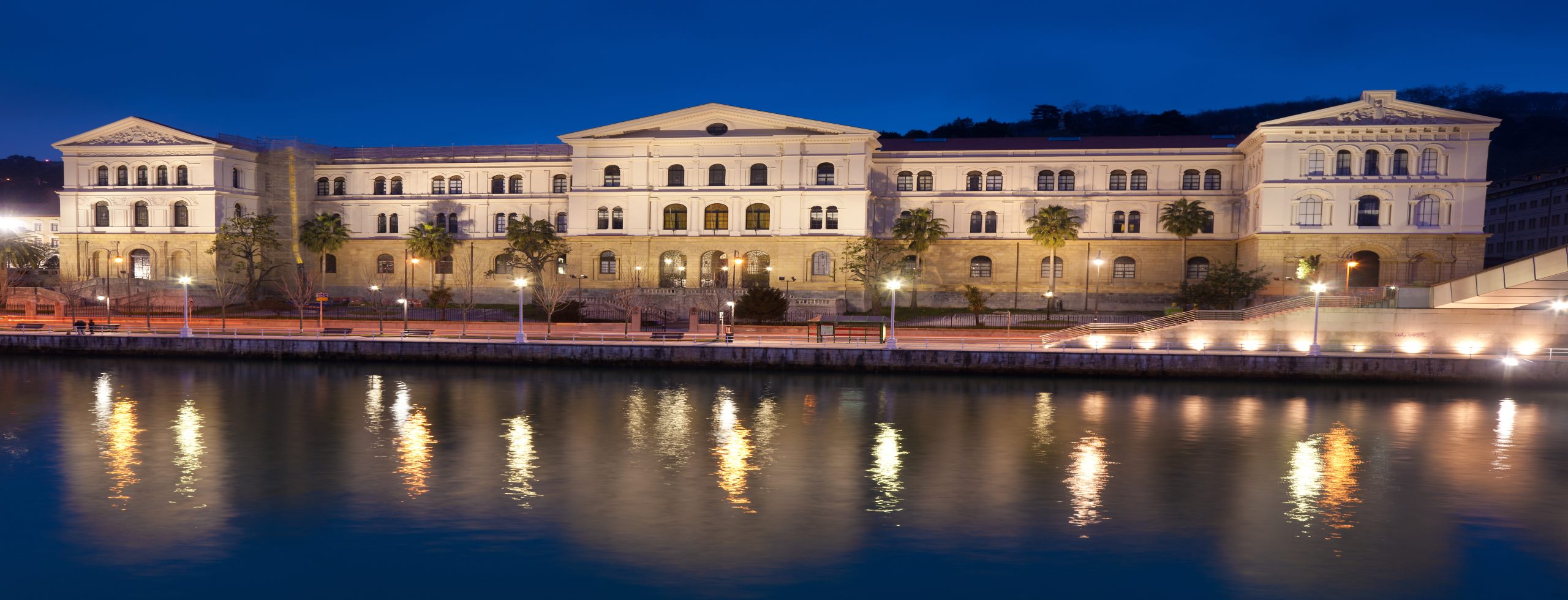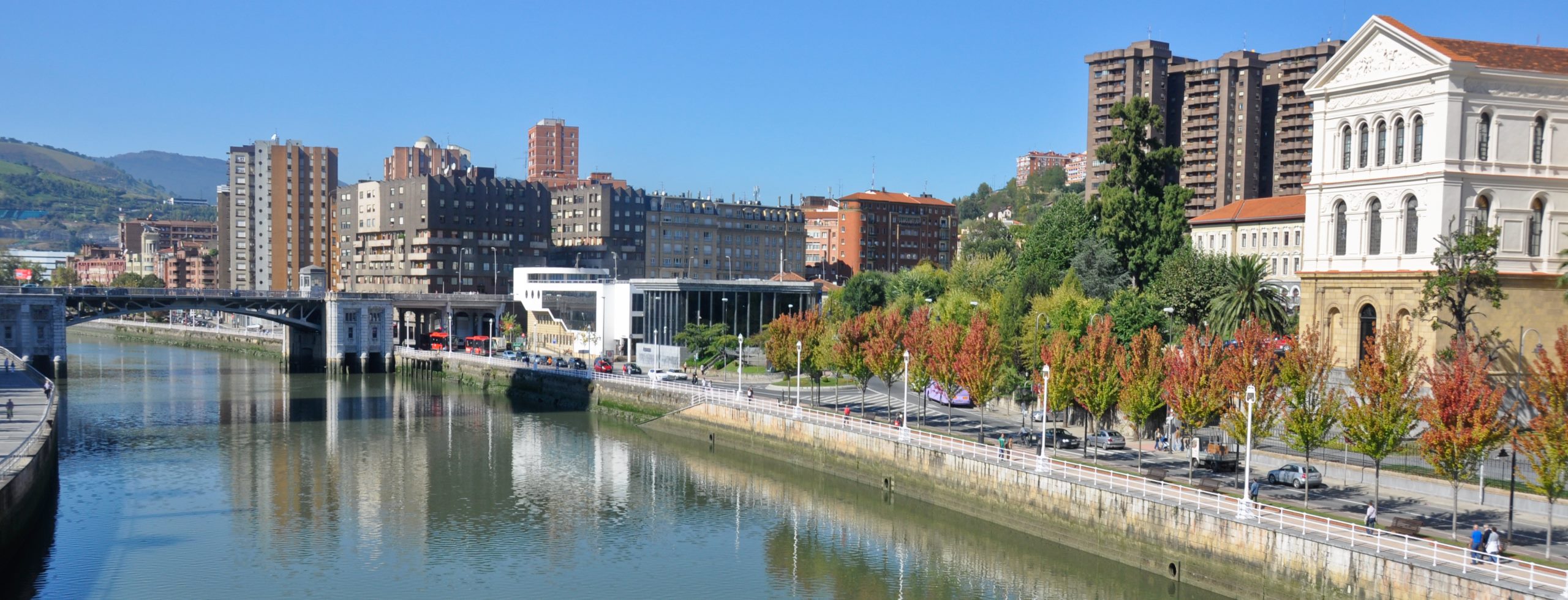One of the main economic and cultural hubs in northern Spain, Bilbao has a cosmopolitan feel and is rich in cultural and gastronomical offerings. As the metropolitan center to more than one million people, the city of Bilbao has been a protagonist in industrial and economic development since the 1300s. Today it is a vigorous service city that continues to experience social and economic revitalization; internationally it has gained recognition as an architectural point of reference, starting from the Bilbao Guggenheim Museum.
There’s no denying that Bilbao is primarily known for the dramatic structure that houses a branch of New York’s Guggenheim Museum – a building designed by the Canadian-American architect Frank Gehry that opened in 1997. Despite initially being drawn to this impressive museum, visitors quickly discover that there is much more to explore and experience in the city. With a population of some 360,000, and another 600,000 in its metropolitan area, Bilbao is Spain’s fifth largest metropolitan area and has the facilities and amenities of any large modern city. Moreover, it is the largest city of the autonomous Basque community of Spain and as such is recognized as its informal capital. The Basque name for the city is actually Bilbo, but the Basques have accepted that the city be known by its Spanish name.
Backed by two modest mountain ranges, Bilbao is situated on the Nervion River some 9 miles/14 kms inland from the Bay of Biscay itself. The river’s estuary, where Bilbao is located, allowed the city to develop into a major commercial port – one that increasingly hosts cruise ships. This region of Spain has also been a major source of iron for centuries. The mining, processing and exporting of this mineral used to be the basis of Bilbao’s industry and economy, although it no longer plays such an important role. Bilbao has essentially converted into a so-called ‘service city’. It is home to large banks, headquarters of both national and international corporations, large construction firms, as well as various other commercial enterprises.
The area of Bilbao was settled long before the Romans appeared in Spain, and remained a settlement through the Middle Ages. Its official founding is dated to the year 1300 when the King of Castile assigned it to a Spanish nobleman. From that point on, Bilbao, along with the rest of the Basque territory, although they prospered economically, essentially remained under the rule of the kings of Spain. As the base of modern industry and commerce, Bilbao and the Basque territory became both a desirable region to control and a center of liberal resistance; it even contributed to the unrest that led to the Civil War in 1936. However, as soon as Franco and his Nationalist forces entered the war, Bilbao became his enemy and paid dearly for this; the city was subjected to bombings by both Franco’s and Germany’s air forces. Under Franco’s rule, Bilbao actually prospered through its industrial activity, but it remained the center of the Basque resistance. With Franco’s death in 1979, Spain became a more open democratic nation and Basques were able to dominate politics in Bilbao.
Visitors to Bilbao will enjoy a modern city with many fine public areas – much of the old city is a pedestrian zone – and civic buildings including planned housing developments. Its cathedral St. James’ of Bilbao dates from at least the 1400s. This church should not be confused with the famed pilgrimage cathedral of St. James’ of Compostela, although Bilbao is in fact one of the major starting points for this pilgrimage. The famous Guggenheim Museum is clearly Bilbao’s top attraction, but in recent years the city has begun to host works by other major architects – its sleek metro system was designed by the British architect Norman Foster, the daring Zubizuri, Basque for “white bridge,” is the work of the Spanish architect Santiago Calatrava, and the spectacular 40-story Iberdrola Tower is by the Argentine architect Cesar Pelli. Bilbao is a diverse city that has much to offer its visitors – you will surely enjoy exploring this cosmopolitan metropolis.
Route 1: Exploring Old Bilbao
Bilbao is a major seaport that has always been a fairly cosmopolitan city; it is also the largest and most industrialized city in Basque Country. The port’s commerce, much of which is based on the iron extracted in this region of Spain, has made Bilbao the economic as well as governmental capital of the Basque Country. This also extended the city beyond its medieval quarter so that by the 19th century it had all the hallmarks of a grand European city – broad avenues, open squares, public parks, gardens, museums, hotels, and mansions. All of these can be seen while enjoying a leisurely walk through the city, although the striking modern buildings do warrant their own tour.
Head to the city’s old quarter called Casco Viejo, on the east bank of the Nervion River that circulates through the city. Be sure to take notice of the still recognizable seven original and parallel streets laid out in the 15th century showing an early form of town planning. Start from the upper town known as Begona with one of the oldest existing buildings of some significance called the Basilica of Begona; parts of this building date to the 16th century and locally it is famous for its painting of the Virgin of Begona to whom returning sailors traditionally pray with thanks when they see the church’s tower. A short walk and down either an elevator or 64 steps of the tower brings you to the 18th century Church of St. Nicholas. There is an archaeological museum nearby that offers some quite unusual displays including the first people who appeared in the Basque Country some 100,000 years ago. Continue on to the 15th century Cathedral of Santiago with its Gothic tower and attractive cloister. Nearby is the Plaza Nueva with its flea market; here you can also retire at one of the many cafes or pinxto bars around the square.
Route 2: Bilbao’s Modern Masterworks
If ever a city owed its reputation to one building, it is probably Bilbao and the Guggenheim Museum. Although Bilbao has its share of fine old buildings, its maritime and industrial facilities and activities have long dominated the city, yet by the 1980s these were in decline. Some visionary members of Bilbao’s government, having learned that the Guggenheim Museum in New York City was considering establishing a satellite museum, committed large sums of money for it to be built in Bilbao. The Guggenheim agreed and commissioned the Canadian-American architect Frank Gehry to design it. Opened to the public in 1997, the building was so original, so unusual, and so dramatic that, although not without some critics, has for the most part been hailed as one of the great works of modern architecture. Viewed from outside its titanium-clad forms remind many of fish scales or billowing sails; the interior is equally irregular, but is basically a great atrium with exhibition spaces extending from its sides. The work exhibited is a mix of loans from the New York Guggenheim’s modern art, Basque and Spanish works, and temporary exhibits. The Bilbao Guggenheim’s contribution to the city does not stop with its architecture and art exhibits, as building it on the riverfront led to the clearing away of unsightly industrial facilities and transforming the entire area.
In addition to this museum, other internationally respected sculptors, architects, and designers have chosen to join Gehry in Bilbao. Sculptures by Louise Bourgeois, Jeff Koons, and Fujiko Nakaya border the Guggenheim, and the Argentinian-American Cesar Pelli was responsible for transforming the riverfront into pleasant promenades and vistas, parks and plazas; he also designed the Iberdola Tower, at 165 meters (541 feet) – the tallest building in all of the Basque Country. Japanese architect Arata Isozaki contributed a tower complex known by his name, and Philipe Starck, a noted French designer, converted the abandoned ruins of an old warehouse into a combination cultural and sporting center known as the Azkuna Zentroa (formerly Alhondiga Bilbao). Spanish architect Santiago Calatrava designed the Zubizuri, the footbridge across the river just down from the Guggenheim and has also designed Bilbao’s new airport terminal, while Norman Foster of Great Britain designed the entrances to the new Metro system. You don’t have to be knowledgeable about modern art and architecture to find a visit these sites both exciting and interesting.
Although remains of an ancient settlement indicate the area was populated in the 3rd or 2nd century BC, Bilbao was officially founded on June 15, 1300 by Diego Lopez V of Haro.
By the 1600s, Bilbao became the capital city of the area and for centuries experienced a steady increase in wealth. Trade was stimulated following the discovery of iron resources and the conquest of the Americas and by the 19th century smokestacks of steelworks, shipbuilding yards and chemical plants dominated the city’s skyline.
During times of war, Bilbao was considered a great prize in the north – mainly because of its industrial value. Even during the Franco era when reprisals were massive and long lasting, Bilbao prospered on account of its industry. Despite its prosperity through the years, in the 1980s, labor demands and a cheap labor force from abroad led to a devastating industrial crisis. Since the 1990s, Bilbao has been in the process of deindustrialization and transition to a service city, supported by investment in infrastructure and urban renewal.



 View Map
View Map 

